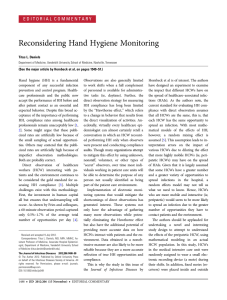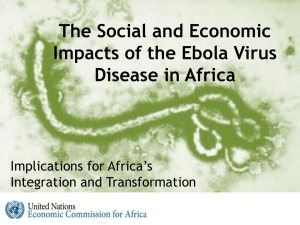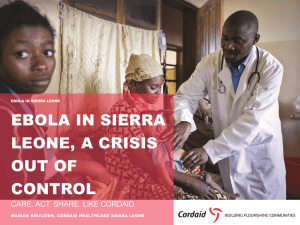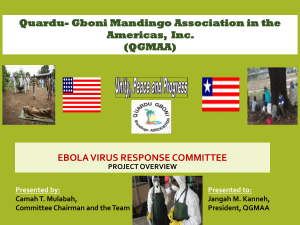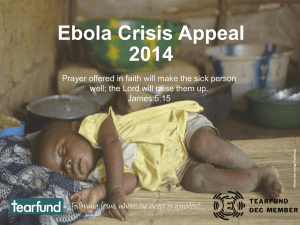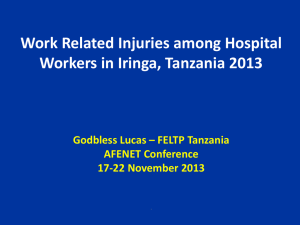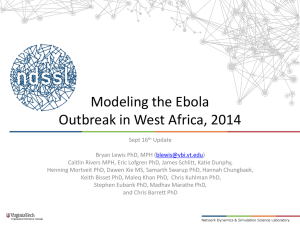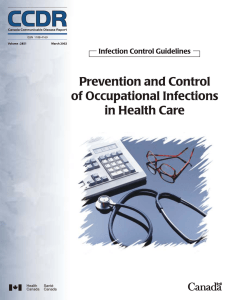Ebola Challenge Final
advertisement
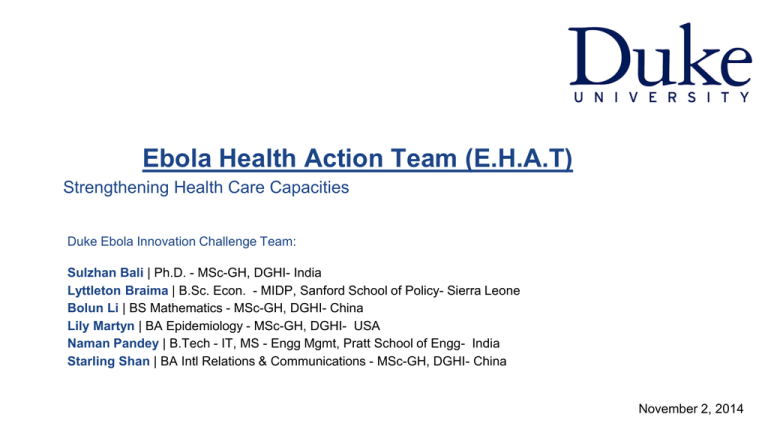
Ebola Health Action Team (E.H.A.T) Strengthening Health Care Capacities Duke Ebola Innovation Challenge Team: Sulzhan Bali | Ph.D. - MSc-GH, DGHI- India Lyttleton Braima | B.Sc. Econ. - MIDP, Sanford School of Policy- Sierra Leone Bolun Li | BS Mathematics - MSc-GH, DGHI- China Lily Martyn | BA Epidemiology - MSc-GH, DGHI- USA Naman Pandey | B.Tech - IT, MS - Engg Mgmt, Pratt School of Engg- India Starling Shan | BA Intl Relations & Communications - MSc-GH, DGHI- China November 2, 2014 E.H.A.T - Strengthening Healthcare Workers Capacity Current Situation & Challenge Healthcare Worker Shortage HCWs Protection Controlling Ebola Outbreak Key Force HCWs Lack of Incentive HR Gap Community Stigma Key Facts • • Our Solution People Deliver Health World Bank Estimation: another 5000 health care workers are needed in West Africa Increase Public Health Awareness Building Capacity for Future Outbreaks E.H.A.T Ebola Healthcare-worker Action Training EHAT Training EHAT Certification EHAT training EHAT KIT Provides essential tools for field work How Will E.H.A.T. Work E.H.A.T. Training Increase the number of HCWs and build health system capacity in long-term E.H.A.T. Kit Provide HCWs with inexpensive but essential tools for personal protection during delivery work 1) Recruit previously trained HCWs and community volunteers 1) Oral Rehydration Sachets (EHAT-ORS) 2) Ensure 1 team (10-20 HCWs) per catchment (rural) or per 2) Pocket book in local language with standard protocols zone (urban) 2) Provide 3 levels of certificate (monetary incentives for level 1 and career opportunities for level 3) 3) Temperature Monitor (continuous temperature sensing with button for emergency and connected to analog phone) 3) Train the team in standardized protocol and buddy system 4) Analog Phone 4) Repeat the training every 6 month at designated community 5) Hand Sanitizer centers Why will EHAT succeed? Sustainable, Scalable, Cost-effective & Holistic Solution Fill the gap of HCW shortage and address issues of recruitment, retention, and inequitable distribution of HCWS in Ebola stricken areas Ensure access to medicine and tools; increase HCWs motivation with supplies Training in standard protocol for EHAT Kit usage and disease management can be duplicate at other community centers Easy copy of 3 level of certificates with WHO support to gain international qualification Tools are inexpensive but essential Hand Sanitizer (< $1) Oral Rehydration Sachets (< $1) Analog Phone (<$15) Temperature Monitor ($6-$10) Reduce community stigma of Ebola and gain pride to be HCWs through spreading awareness by EHAT member from catchment Training will provide HCWs with skills required to work as HCWs for other diseases like childhood infectious diseases, HIV, TB Challenges Community applicability How can EHAT be customized to each country’s needs? Understanding the root & stigma of Ebola fear Are diagnostic capabilities available at PHU? Partnerships, recruitment & retain of HCWs How can we strengthen public-private partnership? Our idea focuses on recruiting and retaining HCWs to build health systems capacity in the Ebola stricken areas Understanding the HCW shortage and HCW distribution in each country Understanding these components in greater detail will help better adapt our design, integrate into the current healthcare structure, and effectively leverage healthcare workers. Additional information- PPE & the EHAT Monitor Source: Personal communication with Avantari founder • Measures temperature • Hypoallergenic clip • 3d battery life • Analog phone compatible, 15 USD • Inexpensive: < 6-10 USD Source: Avantari, manufacturer Reflection Hard Work Different backgrounds, ONE attribute - on Halloween night, we gathered in the living room, costumed as community health workers, and came up with the ultimate solution for Ebola CHW. Knowledge We discussed like we were in a model stakeholders meeting, with perspectives from many sides; there are views from a politician, epidemiologist, technician, economist, business-minded woman, and journalist digging into/questioning all the ideas. Our explosion of ideas were well seasoned through rethinking, refining, and reflecting, eventually becoming the ultimate E.H.A.P strategy. Collaboration It is never easy for a six-headed dragon to attack the same target, but once it does, the target will hardly escape – and our target is EBOLA! We conclude with a graph that suggests to you how to tame a sixheaded dragon: basically you need three things – knowledge, hard work and collaboration. Thank you’s & Outtakes 1. 2. 3. 4. 5. 6. 7. Monitoring healthcare worker’s vitals by regular weekly checkups Ebola Socks - Water resistant, Modeled on Leech Socks Providing clean water in form of Water Packets to affected areas by government Temperature monitoring watches Shoes with anti-perspirant; Laundry bleach + foot powder Troops and military for HCWs safety Sending pictures to doctors for better treatment results Appendix: Understanding the System PHU (primary health unit/peripheral health unit): lowest tier of health service delivery in rural areas: 1. Maternal and Child Health Post (MCHP): ideally should service 500 – 5,000 people in villages within a 3-mile radius 2. Community health post (CHP) should service about 5,000 – 10,000 people in villages within 5-mile radius 3. Community Health Center (CHC) should service about 10,000 – 30,000 people in villages within 5 – 10-mile radius MCHP and CHP are at village level CHC at chiefdom headquarters District hospitals are the main referral centers for the village and chiefdom level facilities. District Hospitals are Located in District Headquarter towns. ● In big towns and cities, target local council wards or divide the city/town into zones to ease operation (management and coordination). ● Private and faith based health clinics/health centers in big towns/cities.
